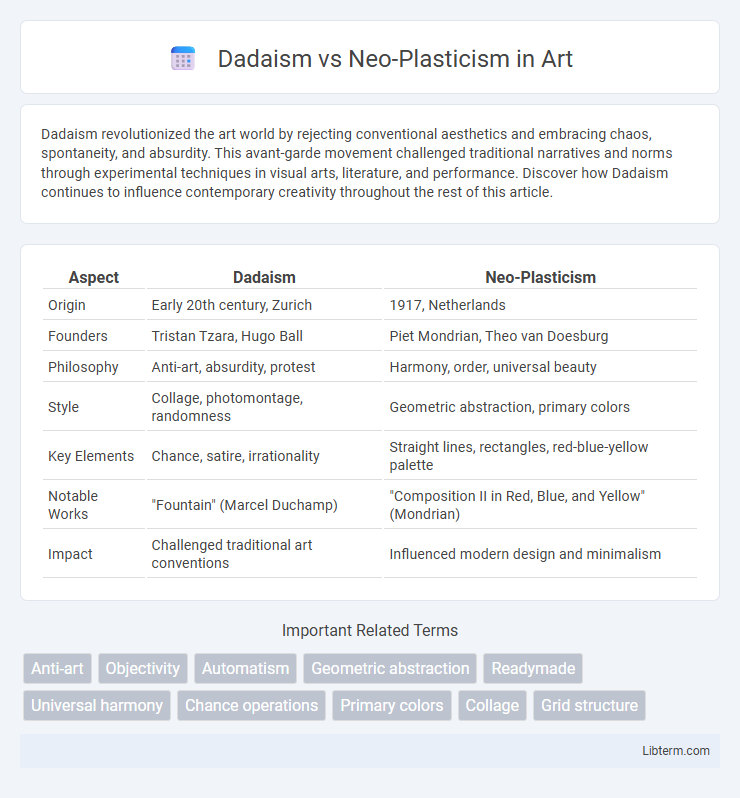Dadaism revolutionized the art world by rejecting conventional aesthetics and embracing chaos, spontaneity, and absurdity. This avant-garde movement challenged traditional narratives and norms through experimental techniques in visual arts, literature, and performance. Discover how Dadaism continues to influence contemporary creativity throughout the rest of this article.
Table of Comparison
| Aspect | Dadaism | Neo-Plasticism |
|---|---|---|
| Origin | Early 20th century, Zurich | 1917, Netherlands |
| Founders | Tristan Tzara, Hugo Ball | Piet Mondrian, Theo van Doesburg |
| Philosophy | Anti-art, absurdity, protest | Harmony, order, universal beauty |
| Style | Collage, photomontage, randomness | Geometric abstraction, primary colors |
| Key Elements | Chance, satire, irrationality | Straight lines, rectangles, red-blue-yellow palette |
| Notable Works | "Fountain" (Marcel Duchamp) | "Composition II in Red, Blue, and Yellow" (Mondrian) |
| Impact | Challenged traditional art conventions | Influenced modern design and minimalism |
Introduction to Dadaism and Neo-Plasticism
Dadaism emerged in the early 20th century as an avant-garde art movement characterized by its anti-establishment stance, embracing chaos, absurdity, and spontaneous creativity to challenge traditional artistic conventions. Neo-Plasticism, founded by Piet Mondrian in the 1910s, focused on geometric abstraction, emphasizing simplicity through the use of primary colors, straight lines, and rectangular forms to create universal harmony. Both movements significantly influenced modern art by redefining aesthetic principles, but Dadaism opposed reason and logic, while Neo-Plasticism sought order and balance.
Historical Context of Dadaism
Dadaism emerged during World War I as a radical artistic response to the horrors and absurdity of the conflict, originating in Zurich in 1916 with figures like Tristan Tzara and Hugo Ball. It rejected traditional aesthetics and embraced chaos, spontaneity, and anti-war politics to protest against bourgeois society and conventional cultural values. Neo-Plasticism, led by Piet Mondrian, developed later in the early 1920s as a structured, utopian art movement focusing on harmony and order through geometric abstraction, directly contrasting Dadaism's anarchic spirit.
Origins and Principles of Neo-Plasticism
Neo-Plasticism, founded by Piet Mondrian in the early 20th century, emerged as a response to chaotic artistic styles, advocating for pure abstraction and universality through a limited palette of primary colors and geometric forms. Rooted in De Stijl movement principles, Neo-Plasticism emphasizes harmony and order by reducing visual elements to vertical and horizontal lines combined with basic color blocks. Unlike the provocative and anti-art Dadaism, Neo-Plasticism seeks to create an ideal aesthetic language reflecting balance and spiritual clarity.
Key Artists and Influencers
Dadaism, pioneered by key artists such as Marcel Duchamp, Hugo Ball, and Hannah Hoch, emphasized anti-art and absurdity, challenging traditional artistic values during the early 20th century. Neo-Plasticism, founded by Piet Mondrian and Theo van Doesburg, focused on abstraction and the reduction of form to basic geometric shapes and primary colors to express universal harmony. Both movements significantly influenced modern art, with Dadaism inspiring conceptual and performance art, while Neo-Plasticism laid foundational principles for abstract and minimalist art.
Philosophical Foundations: Chaos vs Order
Dadaism embraces chaos through its rejection of traditional art conventions and rationality, reflecting a philosophy rooted in absurdity and anti-art sentiments. Neo-Plasticism, pioneered by Piet Mondrian, advocates for a universal order by emphasizing geometric abstraction and harmony through primary colors and straight lines. These opposing philosophies illustrate the fundamental contrast: Dadaism challenges structure with spontaneity and irrationality, while Neo-Plasticism seeks to impose clarity and balance through disciplined composition.
Artistic Techniques: Materials and Methods
Dadaism employs collage, photomontage, and ready-made objects, emphasizing spontaneity and anti-art principles. Neo-Plasticism utilizes precise geometric shapes, primary colors, and flat planes, following strict compositional rules to achieve harmony and balance. Materials in Dada include found objects and mixed media, whereas Neo-Plasticism relies on traditional painting media like oil on canvas with a focus on abstraction and purity.
Visual Language: Abstraction and Meaning
Dadaism employs chaotic visual language characterized by irrational juxtapositions and collage techniques, emphasizing anti-art sentiments and absurdity to challenge conventional meaning. Neo-Plasticism adopts strict abstraction through geometric forms and primary colors, aiming for universal harmony and purity of visual expression. While Dadaism disrupts meaning to provoke critical thought, Neo-Plasticism seeks to convey order and balance through reductive visual elements.
Cultural Impact and Legacy
Dadaism challenged traditional art conventions through its anti-establishment and anti-art ethos, profoundly influencing avant-garde movements and modern conceptual art by rejecting rationality and embracing chaos. Neo-Plasticism, pioneered by Piet Mondrian, fostered a cultural legacy centered on harmony, abstraction, and universal aesthetics, shaping modernist architecture, design, and visual arts with its emphasis on geometric purity and primary colors. Both movements have left enduring impacts: Dadaism disrupted artistic norms and inspired postmodern critique, while Neo-Plasticism established foundational principles for minimalism and contemporary art's search for balance and order.
Criticism and Reception
Dadaism faced intense criticism for its anti-art stance and chaotic aesthetics, challenging traditional artistic values and provoking strong reactions from both critics and the public. Neo-Plasticism, developed by Piet Mondrian, received praise for its rigorous abstraction and pursuit of harmony through geometric forms, yet some critics found it overly rigid and intellectually detached. While Dadaism's reception was marked by controversy and debate on the nature of art, Neo-Plasticism was celebrated in avant-garde circles for its theoretical contributions to modern art.
Lasting Influence on Modern Art
Dadaism revolutionized modern art by challenging traditional aesthetics and embracing absurdity, influencing contemporary movements such as conceptual art and performance. Neo-Plasticism, founded by Piet Mondrian, established a lasting legacy through its emphasis on geometric abstraction and harmony, shaping minimalist and abstract art trends. Both movements contributed foundational principles that continue to inspire innovation in visual art and design.
Dadaism Infographic

 libterm.com
libterm.com